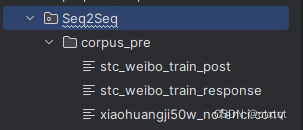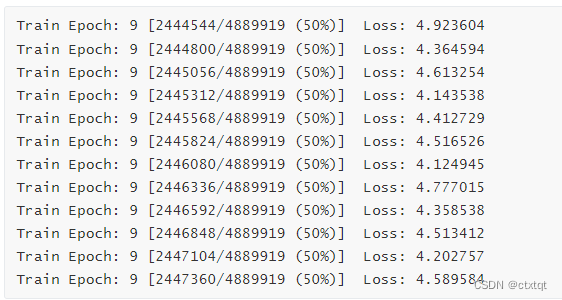二、Seq2Seq
(一)Seq2Seq原理
Seq2seq模型中的encoder接收一个长度为M的序列,得到1个 context vector,之后decoder把这一个context vector转化为长度为N的序列作为输出,从而构成一个M to N的模型,能够处理很多不定长输入输出的问题
(二)Seq2Seq实现
1.实现流程:
文本转换为序列,使用序列,完成encoder、decoder,完成Seq2Seq模型,完成模型训练逻辑与评估逻辑。
准备一个config.py文件记录可变参数,use_word等。
2.准备训练数据:
单轮次聊天数据并不好获取,这里主要用小黄鸡语料以及微博语料。
下载地址:GitHub - codemayq/chinese-chatbot-corpus: 中文公开聊天语料库
存放至:

建立按词与按字分词的input与output文件:

from tqdm import tqdm
from jieba import lcut as jieba_cut
import re
def format_xiaohuangji_corpus(word=False):
"""处理小黄鸡的语料,分为两个部分,一个是input部分,就是发起聊天的语料
output就是回应聊天的语料"""
if word:
corpus_path = "corpus_pre/xiaohuangji50w_nofenci.conv"
input_path = "corpus/input_word.txt"
output_path = "corpus/corpus/output_word.txt"
else:
corpus_path = "corpus_pre/xiaohuangji50w_nofenci.conv"
input_path = "corpus/input.txt"
output_path = "corpus/output.txt"
f_input = open(input_path,"a")
f_output = open(output_path,"a")
pair = []
for line in tqdm(open(corpus_path, encoding='utf-8'),ascii=True):
if line.strip() == "E":
if not pair:
continue
else:
assert len(pair) == 2,"长度必须是2"
if len(pair[0].strip())>=1 and len(pair[1].strip())>=1:
f_input.write(pair[0]+"\n")
f_output.write(pair[1]+"\n")
pair = []
elif line.startswith("M"):
line = line[1:]
if word:
pair.append(" ".join(list(line.strip())))
else:
pair.append(" ".join(jieba_cut(line.strip())))
def format_weibo(word=False):
"""
微博数据存在一些噪声,未处理
:return:
"""
if word:
origin_input = "corpus_pre/stc_weibo_train_post"
input_path = "corpus/input_word.txt"
origin_output = "corpus_pre/stc_weibo_train_response"
output_path = "corpus/output_word.txt"
else:
origin_input = "corpus_pre/stc_weibo_train_post"
input_path = "corpus/input.txt"
origin_output = "corpus_pre/stc_weibo_train_response"
output_path = "corpus/output.txt"
f_input = open(input_path,"a",encoding='utf-8')
f_output = open(output_path, "a",encoding='utf-8')
with open(origin_input, encoding='utf-8') as in_o,open(origin_output,encoding='utf-8') as out_o:
for _in,_out in tqdm(zip(in_o,out_o),ascii=True):
_in = _in.strip()
_out = _out.strip()
if _in.endswith(")") or _in.endswith("」") or _in.endswith(")"):
_in = re.sub("(.*)|「.*?」|\(.*?\)"," ",_in)
"""由于微博语料较多表情与符号,所以需要用正则表达式进行处理"""
_in = re.sub("我在.*?alink|alink|(.*?\d+x\d+.*?)|#|】|【|-+|_+|via.*?:*.*"," ",_in)
_in = re.sub("\s+"," ",_in)
if len(_in)<1 or len(_out)<1:
continue
if word:
_in = re.sub("\s+","",_in) #转化为一整行,不含空格
_out = re.sub("\s+","",_out)
if len(_in)>=1 and len(_out)>=1:
f_input.write(" ".join(list(_in)) + "\n")
f_output.write(" ".join(list(_out)) + "\n")
else:
if len(_in) >= 1 and len(_out) >= 1:
f_input.write(_in.strip()+"\n")
f_output.write(_out.strip()+"\n")
f_input.close()
f_output.close()
if __name__ == '__main__':
format_xiaohuangji_corpus(False)
format_xiaohuangji_corpus(True)
format_weibo(False)
format_weibo(True)报错:
![]()
解决: 添加encoding = ’utf-8‘即可。
调用函数即可。
3.文本转换为序列:
将文本转换为数字再转换为向量:
import config
import pickle
class Word2Sequence():
UNK_TAG = "UNK"
PAD_TAG = "PAD"
SOS_TAG = "SOS"
EOS_TAG = "EOS"
UNK = 0
PAD = 1
SOS = 2
EOS = 3
def __init__(self):
self.dict = {
self.UNK_TAG: self.UNK,
self.PAD_TAG: self.PAD,
self.SOS_TAG: self.SOS,
self.EOS_TAG: self.EOS
}
self.count = {}
self.fited = False
def to_index(self, word):
"""word -> index"""
assert self.fited == True, "必须先进行fit操作"
return self.dict.get(word, self.UNK)
def to_word(self, index):
"""index -> word"""
assert self.fited, "必须先进行fit操作"
if index in self.inversed_dict:
return self.inversed_dict[index]
return self.UNK_TAG
def __len__(self):
return len(self.dict)
def fit(self, sentence):
"""
:param sentence:[word1,word2,word3]
:param min_count: 最小出现的次数
:param max_count: 最大出现的次数
:param max_feature: 总词语的最大数量
:return:
"""
for a in sentence:
if a not in self.count:
self.count[a] = 0
self.count[a] += 1
self.fited = True
def build_vocab(self, min_count=1, max_count=None, max_feature=None):
# 比最小的数量大和比最大的数量小的需要
if min_count is not None:
self.count = {k: v for k, v in self.count.items() if v >= min_count}
if max_count is not None:
self.count = {k: v for k, v in self.count.items() if v <= max_count}
# 限制最大的数量
if isinstance(max_feature, int):
count = sorted(list(self.count.items()), key=lambda x: x[1])
if max_feature is not None and len(count) > max_feature:
count = count[-int(max_feature):]
for w, _ in count:
self.dict[w] = len(self.dict)
else:
for w in sorted(self.count.keys()):
self.dict[w] = len(self.dict)
# 准备一个index->word的字典
self.inversed_dict = dict(zip(self.dict.values(), self.dict.keys()))
def transform(self, sentence, max_len=None, add_eos=False):
"""
实现吧句子转化为数组(向量)
:param sentence:
:param max_len:
:return:
"""
assert self.fited, "必须先进行fit操作"
r = [self.to_index(i) for i in sentence]
if max_len is not None:
if max_len > len(sentence):
if add_eos:
r += [self.EOS] + [self.PAD for _ in range(max_len - len(sentence) - 1)]
else:
r += [self.PAD for _ in range(max_len - len(sentence))]
else:
if add_eos:
r = r[:max_len - 1]
r += [self.EOS]
else:
r = r[:max_len]
else:
if add_eos:
r += [self.EOS]
# print(len(r),r)
return r
def inverse_transform(self, indices):
"""
实现从数组 转化为 向量
:param indices: [1,2,3....]
:return:[word1,word2.....]
"""
sentence = []
for i in indices:
word = self.to_word(i)
sentence.append(word)
return sentence
# 之后导入该word_sequence使用
# word_sequence = pickle.load(open("./ws", "rb")) if not config.use_word else pickle.load(
# open("./ws_word", "rb"))
if __name__ == '__main__':
from tqdm import tqdm
import pickle
word_sequence = Word2Sequence()
# 词语级别
input_path = "corpus/input.txt"
target_path = "corpus/output.txt"
for line in tqdm(open(input_path, encoding='utf-8').readlines()):
word_sequence.fit(line.strip().split())
for line in tqdm(open(target_path, encoding='utf-8').readlines()):
word_sequence.fit(line.strip().split())
# 使用max_feature=5000个数据
word_sequence.build_vocab(min_count=5, max_count=None, max_feature=5000)
print(len(word_sequence))
pickle.dump(word_sequence, open("./ws", "wb"))运行结果:

4.准备DataLoader:
import torch
import config
from torch.utils.data import Dataset,DataLoader
from wordsequence import word_sequence
class ChatDataset(Dataset):
def __init__(self):
super(ChatDataset,self).__init__()
input_path = "corpus/input.txt"
target_path = "corpus/output.txt"
if config.use_word:
input_path = "corpus/input_word.txt"
target_path = "corpus/output_word.txt"
self.input_lines = open(input_path).readlines()
self.target_lines = open(target_path).readlines()
assert len(self.input_lines) == len(self.target_lines) ,"input和target文本的数量必须相同"
def __getitem__(self, index):
input = self.input_lines[index].strip().split()
target = self.target_lines[index].strip().split()
if len(input) == 0 or len(target)==0:
input = self.input_lines[index+1].strip().split()
target = self.target_lines[index+1].strip().split()
#此处句子的长度如果大于max_len,那么应该返回max_len
return input,target,min(len(input),config.max_len),min(len(target),config.max_len)
def __len__(self):
return len(self.input_lines)
def collate_fn(batch):
#1.排序
batch = sorted(batch,key=lambda x:x[2],reverse=True)
input, target, input_length, target_length = zip(*batch)
# 2.进行padding的操作
input = torch.LongTensor([word_sequence.transform(i, max_len=config.max_len) for i in input])
target = torch.LongTensor([word_sequence.transform(i, max_len=config.max_len, add_eos=True) for i in target])
input_length = torch.LongTensor(input_length)
target_length = torch.LongTensor(target_length)
return input, target, input_length, target_length
data_loader = DataLoader(dataset=ChatDataset(),batch_size=config.batch_size,shuffle=True,collate_fn=collate_fn,drop_last=True)5.encoder编码层:
建立一个神经网络,主要有一个embedding层和GRU层(LSTM的变体)
import torch.nn as nn
from wordsequence import word_sequence
import config
class Encoder(nn.Module):
def __init__(self):
super(Encoder,self).__init__()
self.vocab_size = len(word_sequence)
self.dropout = config.dropout
self.embedding_dim = config.embedding_dim
self.embedding = nn.Embedding(num_embeddings=self.vocab_size,embedding_dim=self.embedding_dim,padding_idx=word_sequence.PAD)
self.gru = nn.GRU(input_size=self.embedding_dim,
hidden_size=config.hidden_size,
num_layers=1,
batch_first=True,
dropout=config.dropout)
def forward(self, input,input_length):
embeded = self.embedding(input)
"""
可变长度的tensor
"""
embeded = nn.utils.rnn.pack_padded_sequence(embeded,lengths=input_length,batch_first=True)
#hidden:[1,batch_size,vocab_size]
out,hidden = self.gru(embeded)
out,outputs_length = nn.utils.rnn.pad_packed_sequence(out,batch_first=True,padding_value=word_sequence.PAD)
#hidden [1,batch_size,hidden_size]
return out,hidden6.decoder层:
主要有四层,embedding层、Gru层、全链接层和一个输出softmax层。
forward用于将上一次计算的的的输出与隐层状态传给下一次,forward_step用于向前计算。
import torch
import torch.nn as nn
import config
import random
import torch.nn.functional as F
from wordsequence import word_sequence
class Decoder(nn.Module):
def __init__(self):
super(Decoder,self).__init__()
self.max_seq_len = config.max_len
self.vocab_size = len(word_sequence)
self.embedding_dim = config.embedding_dim
self.dropout = config.dropout
self.embedding = nn.Embedding(num_embeddings=self.vocab_size,embedding_dim=self.embedding_dim,padding_idx=word_sequence.PAD)
self.gru = nn.GRU(input_size=self.embedding_dim,
hidden_size=config.hidden_size,
num_layers=1,
batch_first=True,
dropout=self.dropout)
self.log_softmax = nn.LogSoftmax()
self.fc = nn.Linear(config.hidden_size,self.vocab_size)
def forward(self, encoder_hidden,target,target_length):
# encoder_hidden [batch_size,hidden_size]
# target [batch_size,seq-len]
decoder_input = torch.LongTensor([[word_sequence.SOS]]*config.batch_size).to(config.device)
decoder_outputs = torch.zeros(config.batch_size,config.max_len,self.vocab_size).to(config.device) #[batch_size,seq_len,14]
decoder_hidden = encoder_hidden #[batch_size,hidden_size]
for t in range(config.max_len):
decoder_output_t , decoder_hidden = self.forward_step(decoder_input,decoder_hidden)
decoder_outputs[:,t,:] = decoder_output_t
value, index = torch.topk(decoder_output_t, 1) # index [batch_size,1]
decoder_input = index
return decoder_outputs,decoder_hidden
def forward_step(self,decoder_input,decoder_hidden):
"""
:param decoder_input:[batch_size,1]
:param decoder_hidden: [1,batch_size,hidden_size]
:return: out:[batch_size,vocab_size],decoder_hidden:[1,batch_size,didden_size]
"""
embeded = self.embedding(decoder_input) #embeded: [batch_size,1 , embedding_dim]
out,decoder_hidden = self.gru(embeded,decoder_hidden) #out [1, batch_size, hidden_size]
out = out.squeeze(0)
out = F.log_softmax(self.fc(out),dim=-1)#[batch_Size, vocab_size]
out = out.squeeze(1)
# print("out size:",out.size(),decoder_hidden.size())
return out,decoder_hidden7.完成模型:
将encoder的隐层状态导入decoder中
import torch
import torch.nn as nn
class Seq2Seq(nn.Module):
def __init__(self,encoder,decoder):
super(Seq2Seq,self).__init__()
self.encoder = encoder
self.decoder = decoder
def forward(self, input,target,input_length,target_length):
encoder_outputs,encoder_hidden = self.encoder(input,input_length)
decoder_outputs,decoder_hidden = self.decoder(encoder_hidden,target,target_length)
return decoder_outputs,decoder_hidden
def evaluation(self,inputs,input_length):
encoder_outputs,encoder_hidden = self.encoder(inputs,input_length)
decoded_sentence = self.decoder.evaluation(encoder_hidden)
return decoded_sentence8.评估:
import torch
import config
from torch import optim
import torch.nn as nn
from Encoder import Encoder
from Decoder import Decoder
from seq2seq import Seq2Seq
from Dataset_Dataloader import data_loader as train_dataloader
from wordsequence import word_sequence
encoder = Encoder()
decoder = Decoder()
model = Seq2Seq(encoder,decoder)
#device在config文件中实现
model.to(config.device)
model.load_state_dict(torch.load("model/seq2seq_model"))
optimizer = optim.Adam(model.parameters())
optimizer.load_state_dict(torch.load("model/seq2seq_optimizer"))
criterion= nn.NLLLoss(ignore_index=word_sequence.PAD,reduction="mean")
def get_loss(decoder_outputs,target):
target = target.view(-1) #[batch_size*max_len]
decoder_outputs = decoder_outputs.view(config.batch_size*config.max_len,-1)
return criterion(decoder_outputs,target)
def train(epoch):
for idx,(input,target,input_length,target_len) in enumerate(train_dataloader):
input = input.to(config.device)
target = target.to(config.device)
input_length = input_length.to(config.device)
target_len = target_len.to(config.device)
optimizer.zero_grad()
##[seq_len,batch_size,vocab_size] [batch_size,seq_len]
decoder_outputs,decoder_hidden = model(input,target,input_length,target_len)
loss = get_loss(decoder_outputs,target)
loss.backward()
optimizer.step()
print('Train Epoch: {} [{}/{} ({:.0f}%)]\tLoss: {:.6f}'.format(
epoch, idx * len(input), len(train_dataloader.dataset),
100. * idx / len(train_dataloader), loss.item()))
torch.save(model.state_dict(), "model/seq2seq_model")
torch.save(optimizer.state_dict(), 'model/seq2seq_optimizer')
if __name__ == '__main__':
for i in range(10):
train(i)电脑冒烟了,跑了12个小时:

但可见,效果并不是很好,仅有50%的准确率,loss也高。这是因为在当前模型中,Encoder将一个句子转换为一个向量,然后在Decoder中使用,如果说Encoder输入句子过长,包含了太多其他的信息,这就导致在Decoder中进行编码的过程,有太多噪声干扰,导致较低的准确率和较高的loss。
三、attention:
为了解决上面的问题,我们采用attention机制,即只关注重要的信息。我们不再将encoder的输出状态作为decoder的输入。
(一)attention原理:
参考:Hung-yi Lee
初始化decoder的初始状态Z0,然后这个Z0会与encoder的第一个timestep的output进行match操作,match操作可以是一个神经网络,具体表现为一个矩阵乘法。得到结果进行softmax,让其和为1,并将其结果与原来encoder输出就行加权求和得到c0。然后与z0一起进入decoder层,得到h1。然后以此循环直至decoder的output为终止符。

(二)soft-attention与hard-attention
1.soft-attention:
指的是encoder中输入的每个词语都会计算得到一个注意力的概率。
2.hard-attention:
希望直接从input中找到一个和输出的某个词对应的那一个词。但是由于NLP中词语。和词语之间往往存在联系,不会只关注某一个词语。所以在NLP中我们一般使用soft-attention。
(三)Global-attention and Local-attention:
Global-attention指的是使用的全部的encoder端的输入的attenion的权重
Local-attention指的是使用了部分的encoder端的输入的权重(当前时间步上的encoder的hidden state),这样可以减少计算量,特别是当句子的长度比较长的时候。
我们一般使用全局attention。
全局attention计算权重方法:
将decoder进行矩阵变换得到d1,然后将decoder与encoder的输出进行矩阵乘法得到d2,然后将d1与d2合并为一个矩阵。
(四)代码实现:
其实attention机制简单来说就是,计算权重,采用local-attention的方法。
class Attention(nn.Module):
def __init__(self,method,batch_size,hidden_size):
super(Attention,self).__init__()
self.method = method
self.hidden_size = hidden_size
assert self.method in ["dot","general","concat"],"method 只能是 dot,general,concat,当前是{}".format(self.method)
if self.method == "dot":
pass
elif self.method == "general":
self.Wa = nn.Linear(hidden_size,hidden_size,bias=False)
elif self.method == "concat":
self.Wa = nn.Linear(hidden_size*2,hidden_size,bias=False)
self.Va = nn.Parameter(torch.FloatTensor(batch_size,hidden_size))
def forward(self, hidden,encoder_outputs):
"""
:param hidden:[1,batch_size,hidden_size]
:param encoder_outputs: [batch_size,seq_len,hidden_size]
:return:
"""
batch_size,seq_len,hidden_size = encoder_outputs.size()
hidden = hidden.squeeze(0) #[batch_size,hidden_size]
if self.method == "dot":
return self.dot_score(hidden,encoder_outputs)
elif self.method == "general":
return self.general_score(hidden,encoder_outputs)
elif self.method == "concat":
return self.concat_score(hidden,encoder_outputs)
def _score(self,batch_size,seq_len,hidden,encoder_outputs):
# 速度太慢
# [batch_size,seql_len]
attn_energies = torch.zeros(batch_size,seq_len).to(config.device)
for b in range(batch_size):
for i in range(seq_len):
#encoder_output : [batch_size,seq_len,hidden_size]
#deocder_hidden :[batch_size,hidden_size]
#torch.Size([256, 128]) torch.Size([128]) torch.Size([256, 24, 128]) torch.Size([128])
# print("attn size:",hidden.size(),hidden[b,:].size(),encoder_output.size(),encoder_output[b,i].size())
attn_energies[b,i] = hidden[b,:].dot(encoder_outputs[b,i]) #dot score
return F.softmax(attn_energies).unsqueeze(1) # [batch_size,1,seq_len]
def dot_score(self,hidden,encoder_outputs):
"""
dot attention
:param hidden:[batch_size,hidden_size] --->[batch_size,hidden_size,1]
:param encoder_outputs: [batch_size,seq_len,hidden_size]
:return:
"""
#hiiden :[hidden_size] -->[hidden_size,1] ,encoder_output:[seq_len,hidden_size]
hidden = hidden.unsqueeze(-1)
attn_energies = torch.bmm(encoder_outputs, hidden)
attn_energies = attn_energies.squeeze(-1) #[batch_size,seq_len,1] ==>[batch_size,seq_len]
return F.softmax(attn_energies).unsqueeze(1) # [batch_size,1,seq_len]
def general_score(self,hidden,encoder_outputs):
"""
general attenion
:param batch_size:int
:param hidden: [batch_size,hidden_size]
:param encoder_outputs: [batch_size,seq_len,hidden_size]
:return:
"""
x = self.Wa(hidden) #[batch_size,hidden_size]
x = x.unsqueeze(-1) #[batch_size,hidden_size,1]
attn_energies = torch.bmm(encoder_outputs,x).squeeze(-1) #[batch_size,seq_len,1]
return F.softmax(attn_energies,dim=-1).unsqueeze(1) # [batch_size,1,seq_len]
def concat_score(self,hidden,encoder_outputs):
"""
concat attention
:param batch_size:int
:param hidden: [batch_size,hidden_size]
:param encoder_outputs: [batch_size,seq_len,hidden_size]
:return:
"""
#需要先进行repeat操作,变成和encoder_outputs相同的形状,让每个batch有seq_len个hidden_size
x = hidden.repeat(1,encoder_outputs.size(1),1) ##[batch_size,seq_len,hidden_size]
x = torch.tanh(self.Wa(torch.cat([x,encoder_outputs],dim=-1))) #[batch_size,seq_len,hidden_size*2] --> [batch_size,seq_len,hidden_size]
#va [batch_size,hidden_size] ---> [batch_size,hidden_size,1]
attn_energis = torch.bmm(x,self.Va.unsqueeze(2)) #[batch_size,seq_len,1]
attn_energis = attn_energis.squeeze(-1)
# print("concat attention:",attn_energis.size(),encoder_outputs.size())
return F.softmax(attn_energis,dim=-1).unsqueeze(1) #[batch_size,1,seq_len]将在seq2seq中的forward_step函数进行修改:四、
四、Beam Search
基本的建模以及完成,在模型评估时我们应该选择概率最大的tokenid进行输出,但是得到的句子可能并不通顺,我们叫他为greedy search。所以为了解决输出句子不通顺的问题,我们可以选择累积概率最大的那一个,但是这就意味着句子将会特别长,不方便进行保存。
为了解决以上两个问题,我们采用Beam Search。假设Beam width=2,表示每次保存的最大的概率的个数,这里每次保存两个,在下一个时间步骤一样,也是保留两个,这样就可以达到约束搜索空间大小的目的,从而提高算法的效率。
Beam Search的实现,用数据结构大根堆。
class Beam:
def __init__(self):
self.heap = list() #保存数据的位置
self.beam_width = config.beam_width #保存数据的总数
def add(self,probility,complete,seq,decoder_input,decoder_hidden):
"""
添加数据,同时判断总的数据个数,多则删除
:param probility: 概率乘积
:param complete: 最后一个是否为EOS
:param seq: list,所有token的列表
:param decoder_input: 下一次进行解码的输入,通过前一次获得
:param decoder_hidden: 下一次进行解码的hidden,通过前一次获得
:return:
"""
heapq.heappush(self.heap,[probility,complete,seq,decoder_input,decoder_hidden])
#判断数据的个数,如果大,则弹出。保证数据总个数小于等于3
if len(self.heap)>self.beam_width:
heapq.heappop(self.heap)
def __iter__(self):#让该beam能够被迭代
return iter(self.heap)
在seq2seq中加入以下方法:
# decoder中的新方法
def evaluatoin_beamsearch_heapq(self,encoder_outputs,encoder_hidden):
"""使用 堆 来完成beam search,对是一种优先级的队列,按照优先级顺序存取数据"""
batch_size = encoder_hidden.size(1)
#1. 构造第一次需要的输入数据,保存在堆中
decoder_input = torch.LongTensor([[word_sequence.SOS] * batch_size]).to(config.device)
decoder_hidden = encoder_hidden #需要输入的hidden
prev_beam = Beam()
prev_beam.add(1,False,[decoder_input],decoder_input,decoder_hidden)
while True:
cur_beam = Beam()
#2. 取出堆中的数据,进行forward_step的操作,获得当前时间步的output,hidden
#这里使用下划线进行区分
for _probility,_complete,_seq,_decoder_input,_decoder_hidden in prev_beam:
#判断前一次的_complete是否为True,如果是,则不需要forward
#有可能为True,但是概率并不是最大
if _complete == True:
cur_beam.add(_probility,_complete,_seq,_decoder_input,_decoder_hidden)
else:
decoder_output_t, decoder_hidden,_ = self.forward_step(_decoder_input, _decoder_hidden,encoder_outputs)
value, index = torch.topk(decoder_output_t, config.beam_width) # [batch_size=1,beam_widht=3]
#3. 从output中选择topk(k=beam width)个输出,作为下一次的input
for m, n in zip(value[0], index[0]):
decoder_input = torch.LongTensor([[n]]).to(config.device)
seq = _seq + [n]
probility = _probility * m
if n.item() == word_sequence.EOS:
complete = True
else:
complete = False
#4. 把下一个实践步骤需要的输入等数据保存在一个新的堆中
cur_beam.add(probility,complete,seq,
decoder_input,decoder_hidden)
#5. 获取新的堆中的优先级最高(概率最大)的数据,判断数据是否是EOS结尾或者是否达到最大长度,如果是,停止迭代
best_prob,best_complete,best_seq,_,_ = max(cur_beam)
if best_complete == True or len(best_seq)-1 == config.max_len: #减去sos
return self._prepar_seq(best_seq)
else:
#6. 则重新遍历新的堆中的数据
prev_beam = cur_beam
def _prepar_seq(self,seq):#对结果进行基础的处理,共后续转化为文字使用
if seq[0].item() == word_sequence.SOS:
seq= seq[1:]
if seq[-1].item() == word_sequence.EOS:
seq = seq[:-1]
seq = [i.item() for i in seq]
return seq五、优化
(一)tearch forcing
在RNN的训练中,如果把前一个预测结果作为下一步step的输入,可能会导致步步错,可以考虑在训练过程中将真实值作为下一步输入,也可以用预测结果进行输入,这两种方式交替使用。
use_teacher_forcing = random.random() > 0.5
if use_teacher_forcing: #使用teacher forcing
for t in range(config.max_len):
decoder_output_t, decoder_hidden, decoder_attn_t = self.forward_step(decoder_input, decoder_hidden,
encoder_outputs)
decoder_outputs[:, t, :] = decoder_output_t
#使用正确的输出作为下一步的输入
decoder_input = target[:, t].unsqueeze(1) # [batch_size,1]
else:#不适用teacher forcing,使用预测的输出作为下一步的输入
for t in range(config.max_len):
decoder_output_t ,decoder_hidden,decoder_attn_t = self.forward_step(decoder_input,decoder_hidden,encoder_outputs)
decoder_outputs[:,t,:] = decoder_output_t
value, index = torch.topk(decoder_output_t, 1) # index [batch_size,1]
decoder_input = index(二)对于梯度消失和梯度爆炸的解决方法
梯度裁剪:设置一个阈值,利用nn.utils.clip_grad_norm_方法






















 674
674











 被折叠的 条评论
为什么被折叠?
被折叠的 条评论
为什么被折叠?








